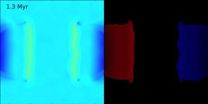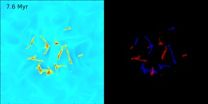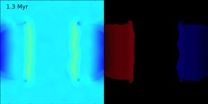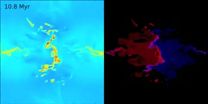(Press-News.org) VIDEO:
This 11-second movie shows a computational simulation of a collision of two converging streams of interstellar gas, leading to collapse and formation of a star cluster at the center. Face-on...
Click here for more information.
Stars are made mostly of hydrogen and helium, but they also contain trace amounts of other elements, such as carbon, oxygen, iron, and even more exotic substances. By carefully measuring the wavelengths (colors) of light coming from a star, astronomers can determine how abundant each of these trace elements is. For any two stars at random, the abundances of their trace elements will slightly differ: one star may have a bit more iron, the other a bit more carbon, etc.
However, astronomers have known for more than a decade that any two stars within the same gravitationally bound star cluster always show the same abundances. "The pattern of abundances is like a DNA fingerprint, where all the members of a family share a common set of genes," said Mark Krumholz, associate professor of astronomy and astrophysics at University of California, Santa Cruz (UCSC).
Being able to measure this "fingerprint" is potentially very useful, because stellar families usually do not stay together. Most stars are born as members of star cluster, but over time they drift apart and migrate across the galaxy. Their abundances, however, are set at birth. Thus, astronomers have long wondered if it might be possible to tell if two stars that are now on opposite sides of the galaxy were born billions of years ago from the same giant molecular cloud. In fact, they further wondered, might it be possible even to find our own Sun's long-lost siblings?
Just one big problem: "Although stars that are part of the same long-lived star cluster today are chemically identical, we had no good reason to think that such family resemblance would hold true of stars that were born together but then dispersed immediately," explained Krumholz. "The underlying problem was that we didn't really know why stars are chemically homogeneous." For example, in a cloud where stars formed rapidly, might the cloud not have had enough time to homogenize thoroughly, thus giving rise to stars born at the same time but not uniform in chemical composition? "Without a real understanding of the physical mechanism that produces uniformity, everything was at best a speculation," he added.
VIDEO:
This 11-second movie shows a computational simulation of a collision of two converging streams of interstellar gas, leading to collapse and formation of a star cluster at the center. Edge-on...
Click here for more information.
Surprising violence
So Krumholz and his graduate student Yi Feng turned to UCSC's Hyades supercomputer to run a fluid dynamics simulation. They simulated two streams of interstellar gas coming together to form a cloud that, over a few million years, collapsed under its own gravity to make a cluster of stars. "We added tracer dyes to the two streams in the simulations, which let us watch how the gas mixed together during this process," Krumholz recounted. They put red dye in one stream and blue dye in the other, but by the time the cloud started to collapse and form stars, everything was purple—and the resulting stars were purple as well. "We found that, as the streams came together, they became extremely turbulent, and the turbulence very effectively mixed together the tracer dyes," he said.
"The simulation revealed exactly why stars that are born together end up having the same trace element abundances: as the cloud that forms them is assembled, it gets thoroughly mixed very fast," Krumholz said. "This was actually a surprise: I didn't expect the turbulence to be as violent as it was, and so I didn't expect the mixing to be as rapid or efficient. I thought we'd get some blue stars and some red stars, instead of getting all purple stars."
In other runs of the simulation, Krumholz and Feng observed that even clouds that do not turn much of their gas into stars—as the Sun's parent cloud probably didn't—still produce stars with nearly-identical abundances. "We've provided the missing physical explanation of how and why chemical mixing works, and shown convincingly that the chemical mixing process is very general and rapid even in an environment which did not yield a star cluster, like the one where the Sun must have formed," said Krumholz.
The finding puts the idea of chemical tagging on much firmer footing. "This is good news for prospects for finding the Sun's long-lost siblings," Krumholz stated.
INFORMATION:
For more information:
The paper "Early turbulent mixing as the origin of chemical homogeneity in open star clusters" is published in the August 31 online issue of Nature. A preprint appears at https://sites.google.com/a/ucsc.edu/krumholz/publications/feng14a.pdf.
The UCSC press release "Mixing in star-forming clouds explains why sibling stars look alike" is at http://news.ucsc.edu/2014/08/star-formation.html (URL will be live on Tuesday, September 2).
This work was supported by the National Science Foundation and the National Aeronautics and Space Administration; the Hyades supercomputer was obtained in part through funding from the University of California High-Performance AstroComputing (UC-HiPACC).
The University of California High-Performance AstroComputing Center (UC-HIPACC), based at the University of California, Santa Cruz, is a consortium of nine University of California campuses and three affiliated Department of Energy laboratories (Lawrence Berkeley Laboratory, Lawrence Livermore Laboratory, and Los Alamos National Laboratory). UC-HiPACC fosters collaborations among researchers at the various sites by offering travel and other grants, co-sponsoring conferences, and drawing attention to the world-class resources for computational astronomy within the University of California system. More information appears at http://hipacc.ucsc.edu.
Illustration, movies, and caption:
The two 11-second movies from the computational simulation can be found in the AstroViz Gallery of the UC-HiPACC website at http://hipacc.ucsc.edu/PressRelease/sibling-stars_videos.html. They are also available at Mark Krumholz's website at https://sites.google.com/a/ucsc.edu/krumholz/movies and on individual pages on Vimeo at http://vimeo.com/104368279 and http://vimeo.com/104368278 .
Two alternative still illustrations, both with the face-on movie shown at top and the edge-on movie at the bottom; the same caption can be used for either illustration or the movies:
CAPTION: Two 11-second movies shows a computational simulation of a collision of two converging streams of interstellar gas, leading to collapse and formation of a star cluster at the center. In both movies, the numbers rapidly increasing shows the passage of time in millions of years; left panel shows the density of interstellar gas (yellow and red are densest) and right panel shows red and blue "tracer dyes" added to watch how the gas mixes during the collapse. Face-on view (upper pair in the stills) shows the plane where the two gas streams meet while the edge-on view (lower pair in the stills) shows a cross section through the two streams. Circles outlined in black are stars; stars are shown as white in the left panel, and in the right panel their color reflects the amount of the two tracer dyes in each star. The simulation reveals that gas streams are thoroughly homogenized within a very short time of converging, well before stars begin forming. Credit for both stills and movies: Mark Krumholz/University of California, Santa Cruz
Why sibling stars look alike: Early, fast mixing in star-birth clouds
Findings from computational simulations by UC Santa Cruz astrophysicists published in Nature online Aug. 31
2014-08-31
ELSE PRESS RELEASES FROM THIS DATE:
Mixing in star-forming clouds explains why sibling stars look alike
2014-08-31
VIDEO:
This computer simulation shows the collision of two streams of interstellar gas, leading to gravitational collapse of the gas and the formation of a star cluster at the center. The...
Click here for more information.
The chemical uniformity of stars in the same cluster is the result of turbulent mixing in the clouds of gas where star formation occurs, according to a study by astrophysicists at the University of California, Santa Cruz. Their results, published August 31 in ...
Antarctic sea-level rising faster than global rate
2014-08-31
A new study of satellite data from the last 19 years reveals that fresh water from melting glaciers has caused the sea-level around the coast of Antarctica to rise by 2cm more than the global average of 6cm.
Researchers at the University of Southampton detected the rapid rise in sea-level by studying satellite scans of a region that spans more than a million square kilometres.
The melting of the Antarctic ice sheet and the thinning of floating ice shelves has contributed an excess of around 350 gigatonnes of freshwater to the surrounding ocean. This has led to a reduction ...
Changing global diets is vital to reducing climate change
2014-08-31
A new study, published today in Nature Climate Change, suggests that – if current trends continue – food production alone will reach, if not exceed, the global targets for total greenhouse gas (GHG) emissions in 2050.
The study's authors say we should all think carefully about the food we choose and its environmental impact. A shift to healthier diets across the world is just one of a number of actions that need to be taken to avoid dangerous climate change and ensure there is enough food for all.
As populations rise and global tastes shift towards meat-heavy Western ...
A new way to diagnose malaria
2014-08-31
CAMBRIDGE, MA -- Over the past several decades, malaria diagnosis has changed very little. After taking a blood sample from a patient, a technician smears the blood across a glass slide, stains it with a special dye, and looks under a microscope for the Plasmodium parasite, which causes the disease. This approach gives an accurate count of how many parasites are in the blood — an important measure of disease severity — but is not ideal because there is potential for human error.
A research team from the Singapore-MIT Alliance for Research and Technology (SMART) has now ...
Memory and Alzheimer's: Towards a better comprehension of the dynamic mechanisms
2014-08-31
This news release is available in French. Montréal, August 31, 2014 – A study just published in the prestigious Nature Neuroscience journal by, Sylvain Williams, PhD, and his team, of the Research Centre of the Douglas Mental Health University Institute and McGill University, opens the door towards better understanding of the neural circuitry and dynamic mechanisms controlling memory as well of the role of an essential element of the hippocampus – a sub-region named the subiculum.
In 2009, they developed a unique approach – namely, the in vitro preparation of a hippocampal ...
Renal denervation reduces recurrent AF after ablation
2014-08-31
Barcelona, Spain – Sunday 31 August 2014: Renal denervation reduces recurrent atrial fibrillation (AF) when performed with pulmonary vein isolation ablation in patients with AF and hypertension, according to research presented at ESC Congress today by Dr Alexander Romanov from the Russian Federation.
Dr Romanov said: "The prevalence of AF ranges from 1.5 to 2% in developed countries. This arrhythmia is associated with increased mortality, a five-fold risk of stroke and a 3-fold incidence of congestive heart failure. The vast majority of patients with AF also have arterial ...
Energy drinks cause heart problems
2014-08-31
Barcelona, Spain – Sunday 31 August 2014: Energy drinks can cause heart problems according to research presented at ESC Congress 2014 today by Professor Milou-Daniel Drici from France.
Professor Drici said: "So-called 'energy drinks' are popular in dance clubs and during physical exercise, with people sometimes consuming a number of drinks one after the other. This situation can lead to a number of adverse conditions including angina, cardiac arrhythmia (irregular heartbeat) and even sudden death."
He added: "Around 96% of these drinks contain caffeine, with a typical ...
Antihypertensive therapy reduces CV events, strokes and mortality in older adults
2014-08-31
Barcelona, Spain – Sunday 31 August 2014: Antihypertensive therapy reduces the risk of cardiovascular (CV) events, strokes and mortality in hypertensive older adults, according to research presented at ESC Congress 2014 today by Dr Maciej Ostrowski from Poland. The findings suggest that antihypertensive drugs should be considered in all patients over 65 years of age with hypertension.
Dr Ostrowski said: "Over the past few decades, a number of randomised trials and meta‑analyses have supported the benefits of antihypertensive medication in reducing the incidence ...
Resistant hypertension increases stroke risk by 35 percent in women and 20 percent in elderly Taiwanese
2014-08-31
Barcelona, Spain – Sunday 31 August 2014: Resistant hypertension increases the risk of stroke by 35% in women and 20% in elderly Taiwanese patients, according to research presented at ESC Congress today by Dr Kuo-Yang Wang from Taiwan. The findings suggest that gender and age should be added to the risk stratification of resistant hypertension to enable more appropriate treatment decisions.
Dr Wang said: "Hypertension is one of the most important risk factors for cardiovascular disease. Patients with hypertension that does not respond to conventional drug treatments, ...
Obese youths have a nearly 6 fold risk of hypertension
2014-08-31
Barcelona, Spain – Sunday 31 August 2014: Obese youths have a nearly six fold risk of hypertension, according to research in more than
22 000 young people from the PEP Family Heart Study presented at ESC Congress today by Professor Peter Schwandt from Germany.
Professor Schwandt said: "The prevalence of hypertension and obesity in children and adolescents is continuing to rise in most high and middle-income countries. Because adiposity is considered a driving force for cardiovascular disease, we examined whether elevated blood pressure was associated with body fat distribution ...
LAST 30 PRESS RELEASES:
Plastic food packaging contains harmful substances
Spring snow, sparkling in the sun, can reveal more than just good skiing conditions
Using AI to improve diagnosis of rare genetic disorders
Study unveils balance of AI and preserving humanity in health care
Capturing and visualizing the phase transition mediated thermal stress of thermal barrier coating materials via a cross-scale integrated computational approach
Study reveals emotional turmoil experienced after dog-theft is like that of a caregiver losing a child
PhRMA Foundation awards $1M for equity-focused research on digital health tools
Women with heart disease are less likely to receive life-saving drugs than men
How electric vehicle drivers can escape range anxiety
How do birds flock? Researchers do the math to reveal previously unknown aerodynamic phenomenon
Experts call for global genetic warning system to combat the next pandemic and antimicrobial resistance
Genetic variations may predispose people to Parkinson’s disease following long-term pesticide exposure, study finds
Deer are expanding north, and that’s not good for caribou
Puzzling link between depression and cardiovascular disease explained at last: they partly develop from the same gene module
Synthetic droplets cause a stir in the primordial soup
Future parents more likely to get RSV vaccine when pregnant if aware that RSV can be a serious illness in infants
Microbiota enterotoxigenic Bacteroides fragilis-secreted BFT-1 promotes breast cancer cell stemness and chemoresistance through its functional receptor NOD1
The Lundquist Institute receives $2.6 million grant from U.S. Army Medical Research Acquisition Activity to develop wearable biosensors
Understanding the cellular mechanisms of obesity-induced inflammation and metabolic dysfunction
Study highlights increased risk of second cancers among breast cancer survivors
International DNA Day launch for Hong Kong’s Moonshot for Biology
New scientific resources map food components to improve human and environmental health
Mass General Brigham research identifies pitfalls and opportunities for generative artificial intelligence in patient messaging systems
Opioids during pregnancy not linked to substantially increased risk of psychiatric disorders in children
Universities and schools urged to ban alcohol industry-backed health advice
From Uber ratings to credit scores: What’s lost in a society that counts and sorts everything?
Political ‘color’ affects pollution control spending in the US
Managing meandering waterways in a changing world
Expert sounds alarm as mosquito-borne diseases becoming a global phenomenon in a warmer more populated world
Climate change is multiplying the threat caused by antimicrobial resistance
[Press-News.org] Why sibling stars look alike: Early, fast mixing in star-birth cloudsFindings from computational simulations by UC Santa Cruz astrophysicists published in Nature online Aug. 31







